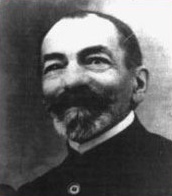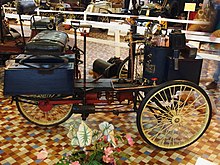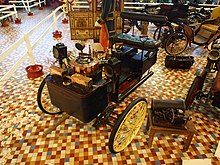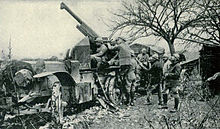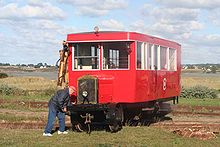De Dion-Bouton
| De Dion-Bouton
|
|
|---|---|
| legal form | |
| founding | 1883 |
| resolution | 1968 |
| Seat | Puteaux , France |
| management | Albert de Dion |
De Dion-Bouton was a French industrial company that was mainly active as a vehicle manufacturer. At the beginning of the 20th century, De Dion-Bouton was the largest automobile manufacturer in the world and world market leader for internal combustion engines .
Beginnings
Charles-Armand Trépardoux and Georges Bouton
The railway engineer Charles-Armand Trépardoux (1853–1920) and the mechanic Georges Bouton (1847–1938) founded a mechanical workshop for physical apparatus and high-precision at the Passage Léon , near the Rue de La Chapelle in the 18th arrondissement of Paris at the end of the 1870s Equipment.
Bouton grew up in Honfleur in Brittany , received a mechanical training there and then worked in Honfleur and Le Havre as a machinist, mechanic and boiler maker. After his military service in the Franco-Prussian War 1870–1871, he had jobs in Paris - Saint Denis , Argenteuil , Bezons and most recently as a mechanic and boiler maker at Hermann La Chapelle, Pierron & Detraitre in Saint Denis. At that time he lived with his sister Eugènie Ernestine (1854–1890) in the 18th arrondissement of Paris .
Charles-Armand Trépardoux came from Arcueil-Cachan in the Ile de France . He was a graduate of the École impériale des Arts et Métiers in Angers and a specialist in steam boiler construction . He too was drafted and did military service in a pioneer regiment . He then worked as a technical draftsman in Paris and married in 1877. He lived in Bouton's neighborhood. Widowed at an early age, he entered into a second marriage to Eugènie Bouton in 1879.
The joint company made only modest sales, so the two presented the way individual productions of technical toys forth like miniature steam engines , steam - model ships or -eisenbahnen . The most important buyer for this was found in the exclusive Giroux store on the Boulevard des Italiens . This also commissioned work and offered it to its wealthy clientele. The mechanical toys by Bouton and Trépardoux were considered to be particularly carefully designed and built, but with eight francs as an average daily income, they contributed little to sales.
Bouton boiler and the Count de Dion
Despite these difficulties, they worked in their free time to develop a new, very light and powerful steam boiler . Engineer Trépardoux, a specialist in rapid evaporation, provided the basis for this. The fact that the two were given the opportunity to successfully complete the work on the boiler was the result of a business relationship that Trépardoux and Bouton entered into with Albert de Dion (1856-1946) around 1881 , where they were initially his employees. Although the kettle is usually ascribed to Bouton, there can be little doubt that the construction was largely Trépardoux 'work, no doubt a consequence of the later development of the company with the dispute with Trépardoux. Today it is known as both the Bouton kettle and the Trépardoux kettle .
The fact that the extraordinarily wealthy Comte Albert de Dion came into contact with Bouton and Trépardoux was more or less by chance. Before Christmas 1881, de Dion saw one of the model steam engines from the workshop of Bouton and Trépardoux in the window of the Giroux shop , inquired about the builders and then contacted Bouton.
According to an older source, the impetus to build the boiler came later. According to this, the count had only informed his employees, who were still employed at the time, months later that he was planning to build a light steam car . Bouton is said to have objected that there was no kettle that was light enough for this purpose. The count said that they would then have to design one.
Earlier boilers were derived from locomotive construction and were very heavy. To keep them in operation, large supplies of water and coal had to be carried along, often on a towed tender . All of this required a massive construction of the chassis, which also caused additional weight. Such vehicles are difficult to maneuver and generally require one person as a driver and another as a stoker ("chauffeur") to operate. However, the brothers Henri and Léon Serpollet had already patented a high-speed steam boiler in 1881 , which was also suitable for road vehicles.
It was the financial resources of Count de Dion that made the construction of the boiler and later the vehicle possible. He himself had great mechanical talent and showed an interest in steam technology since his youth. As a student in Germany, he had built a model steam engine himself. De Dion, with his full name Jules-Félix Philippe Albert de Malfiance, Comte de Dion de Wandonne , came from a very old family from the high nobility, whose head was allowed to bear the title of Marquis even before Napoléon . Since the founding of the state of Belgium in 1830, there have been two lines of this noble house, one French and one Belgian. Albert comes from the French branch. He was a Count (Comte) by birth and inherited the title of Marquis from his father in 1901 after his father's death . He was related to Henri de Dion .
Trépardoux et Cie, ingénieurs-constructeurs
From these beginnings, the company Trépardoux et Cie, ingénieurs-constructeurs at 22 rue Tronchet, not far from Porte Maillot , emerged in 1882 . The name was chosen because Trépardoux had a degree in engineering, which had a confidence-building effect. Possibly family circumstances on the part of the count also played a role; His interest in technology was considered inappropriate by the nobility and was strictly rejected by his father.
The company's first project was the compact and quickly heatable steam boiler, which was patented in France in 1883 with the number 155 206. De Dion was a tough businessman. As an investor, he dictated a partnership agreement that secured 80% of his income, but obliged Trépardoux and Bouton to work exclusively for the company.
Steam car
Trépardoux & Cie. moved in 1883 to the nearby Rue Pergolèse 22 in the 17th arrondissement of Paris . Shortly thereafter, the company introduced its first steam car , called Quadricycle ("four-wheel"). It was driven by a steam engine on each of the front wheels. These were larger than the rear ones and, similar to Bollée's constructions, hung individually . Were steered with the rear wheels, which had a narrower track . The steering mechanism was rather primitive with a turntable on which the axle was suspended. The two-piston machine was designed so that each of the two pistons transmitted the power to one of the front wheels via a chain. The vehicle was considered “light” and could be operated by one person; other constructions such as those by Amédée Bollée were heavier, more expensive and often required an additional heater.
In the same year 1883, the company received the patent for its light boiler and began marketing it. It was initially developed for 4 HP machines and was later made in different sizes. It was mainly used in pleasure boats and yachts on the Seine, and the French Navy also used it for some of their torpedo boats .
Relocation to Puteaux and Établissements De Dion, Bouton & Trépardoux
The company grew, not least thanks to de Dion's relationships, and again needed larger premises. These were moved into in 1884 at 20 rue des Pavillons in Puteaux . Over 20 employees have already been employed. Correspondence that has survived shows that the company was known as Trépardoux & Cie. Until at least 1886 . traded. It is not known when the Count entered into a partnership (albeit not on an equal footing) with Bouton and Trépardoux; It is documented from 1887. It is conceivable, however, that it was formally established earlier and that Albert kept it a secret from his father.
Steam tricycles and quadricycles
As early as 1884, after a number of test vehicles, two steam-powered tricycles appeared (not to be confused with the later gasoline-powered De Dion Bouton motor tricycles ). Now there was only one drive source and this patented two-piston machine was built into the vehicle in such a way that each of the two pistons transmitted its power via a chain directly to one of the front wheels. The vehicle was considered “light” and could be operated by one person; other designs were heavier, more expensive, and often required an additional heater.
Self-driving road vehicles were still a hobby for a few and it was uncertain whether automobiles would catch on. The fact that the company continued to engage in such attempts posed a considerable risk. Also in 1884, a second quadricycle was created with La Marquise . This vehicle is the first “racing car” in the world, the oldest surviving vehicle from this manufacturer and possibly also the oldest surviving “family car” in the world. La Marquise had a standing boiler at the front and two independently working steam engines, each with a power of 2 HP (according to the calculation method used at the time). The power was transmitted to a front wheel via a chain. The rear wheels were used for steering; the track on the rear axle was also significantly narrower here than on the front . The water supply was carried in a rectangular tank in the stern.
A steam tricycle from 1887 is said to have reached a speed of 65 km / h.
Look for the light steam car
Sales documents from 1886 advertise "tractors, boilers that cannot explode, automobiles, luxury cars and trams". Tractors were vehicles which, analogous to modern articulated lorries , had a mount in the rear. Carriages were attached here, the steerable front axle had previously been removed. In 1893 a new generation of these remorqueurs was introduced, which used the newly patented De-Dion axle . In the following year, Count de Dion drove the Paris – Rouen race with such a tractor, accompanied by five people, four of them in the attached carriage.
In 1886 steam cars were offered in various sizes, such as a dogcart with 2, 3 or 4 seats, a Phaeton also with 4 seats, an extremely expensive Berline de Voyage with 9 hp and 3 tons weight, an omnibus with 18 seats (this is a forerunner the MPV ) and a tram car with 42 seats. It should have been a bus. The dogcart and the steam tricycle not yet mentioned were the company's first vehicles that managed without an additional heater. The tricycle remained available until 1890.
partner
One of the early customers was Gaston de Chasseloup-Laubat , who bought a steam mobile back in 1885. The aristocrat used it on several reliability trips and in 1897 was able to win one of them, Marseille-La Turbie .
In 1887 the company was reorganized as Etablissements De Dion, Bouton & Trépardoux . Only now did the employees Bouton and Trépardoux become partners of the Count. They each had a 20 percent share in the success. The fact that de Dion made the decisions as financier did not change and the two were still obliged to make all their work available to the company; the company was entitled to evaluate their work, i.e. license fees from submitted patents. This presented an improved version of the boiler at the World Exhibition in Paris in 1889 in the Geneste-Herscher pavilion.
The count had already started to deal with combustion engines . From 1889 he had a design office independent of the company on Rue St. Maur, in which an engineer named Delalande worked. It seems that the count sketched constructions that Delalande worked out afterwards. These designs were very advanced. There were two rotary engines with four and 12 cylinders respectively. They anticipated elements of the successful Gnome aircraft engines introduced 15 years later . The count received a personal patent for the four-cylinder. These engines can be regarded as the ancestors of the star piston aircraft engines .
Trépardoux, on the other hand, remained a strong proponent of the steam drive, which led to increasing tension.
De Dion, Bouton & Trepardoux La Marquise (1884). The vehicle is considered to be the first racing car, the first family car and the oldest surviving of the brand.
Albert de Dion drives a steam remorqueur with a “Victoria” carriage at the Paris – Rouen race (1894). He reached the goal first. Illustration on an Afghan postage stamp.
Steam remorqueur with a combined payload and tensile load of 10 tons (1899)
Steam bus with Georges Bouton on the handlebars (1899)
The De Dion rear axle
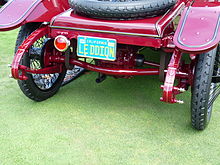
Another, no less important innovation was the development of a new type of rear axle, which was patented in 1893. The De-Dion axle is a driven rigid axle . Instead of using the shafts and susceptible drive chains that were customary at the time, De Dion connected the differential, which was still separate from the axle, directly to the wheels via cardan shafts. Because of the name, the invention is often attributed to Count de Dion. It is true, however, that this invention is the work of Armand-Charles Trépardoux . However , due to the employer's exclusivity clause, the patent was applied for and issued to the company. This construction was used by many manufacturers and has been in use until recently (for example in the Smart ), but was gradually replaced by De Dion-Bouton as early as 1912.
Internal combustion engines and their different assessment
When this rear axle was developed, De Dion was already interested in the gasoline engine as a much lighter alternative to the steam engine. He had first seen combustion engines at the World Exhibition in Paris in 1889, where the Bouton boiler was also shown. He had to realize that the desired goal of a cheap, light automobile could not be achieved with the steam drive. The country's most innovative automobile manufacturer at the time, Panhard & Levassor , had already applied for a license to produce Daimler engines. The count was also convinced of the future of the new engine and decided to manufacture his own internal combustion engines. This met with resistance from Trépardoux, who tried unsuccessfully to influence his brother-in-law. In his opinion, the new technology was immature and significantly more unreliable than the tried and tested steam drive that had been known for decades. He thought the new focus on combustion engines was "childish" and the Count had to be convinced that steam technology alone had a promising future. De Dion, of course, became aware of this opposition very early on. But the break did not yet occur, not least because he valued Trépardoux's extraordinary skills as an engineer and technician. The company continued to produce steam engines and vehicles for several years.
The efforts of de Dion and Delalande resulted in experimental engines in 1889/1890. One of them was a two-cylinder two - stroke engine , in the construction of which elements of the steam engine were used. It was supposed to replace the steam drive of the tricycles without having to change their basic structure. The idea does not appear to have been pursued after de Dion transferred the work to Bouton in 1891 or 1892.
The separation from Trépardoux
The simmering conflict between Count de Dion and Armand-Charles Trépardoux finally broke out openly when the Count announced his intention to gradually switch over to internal combustion engines and to give up steam engines. There was a very noisy argument between the two, followed by Trépardoux's immediate departure on May 27, 1893. The name was changed to De Dion-Bouton immediately. It is believed that the irascible count caused the brass type plates to be exchanged for those with the new company name on the occasion of maintenance and repair work on the customers' machines.
With regard to steam engines, Trépardoux was partially right in the years to come: private steam-powered cars could hardly be sold, but there was definitely a market for commercial vehicles. Until the first few years of the next century, steam trucks and tugs proved to be at least competitive. De Dion-Bouton's competitors Darracq-Serpollet and Scotte also experienced this .
The single cylinder engine
The De Dion Bouton single-cylinder engine was the first "high-speed" four-stroke - combustion engine and the most produced gasoline-powered power source was their time. Engineer Delalande worked on the development for about a year. He was supported early on by Georges Bouton. A patent was issued as early as 1890. From 1893, further development took place entirely at De Dion, Bouton & Trépardoux. This was the aforementioned trigger for the separation from Charles-Armand Trépardoux and led to the reorganization of the company as De Dion-Bouton . Overall, the development of the single cylinder engine took six years; most of this goes to Georges Bouton. The prototype was a simple, light , air-cooled four-stroke engine . It had two flywheel disks (like the Daimler engine) with crank pins in between . The housing was made of aluminum ; this is the oldest known application of light metal in an internal combustion engine as a means of saving weight. Bouton used an automatic intake valve and a controlled exhaust valve for the small engine . It developed 0.5 HP from 138 cm³ (bore × stroke: 50 × 70 mm).
Before the First World War
Passenger cars and motor tricycles
The company achieved a number of innovations , for example a single-cylinder gasoline-powered engine was patented in 1890 , and the De-Dion axle was invented in 1893 . The De Dion Bouton motor tricycle with gasoline engine, presented in 1897, was the most successful motor vehicle in Europe up to the turn of the century. With around 15,000 units sold, the motor tricycle achieved its first breakthrough in the spread of motor vehicles.
In 1895 the construction of smaller steam cars was stopped. Passenger cars with gasoline engines appeared in 1898; this drive was characterized by its low weight and high speeds. It was so successful that many other brands were powered with a De Dion Bouton engine .
In 1900 the brand was the largest automobile manufacturer in the world with 400 cars built and 3,200 engines. The backbone of the company was still the single-cylinder Voiturette , and in 1910 a 35 hp V8 engine was manufactured. The last single-cylinder car was built in 1913.
commercial vehicles
The sale of steam cars to private users only made up a very small part of sales; commercial vehicle construction was far more important. Omnibuses were also produced, initially with steam and then with gasoline. The last heavy steam trucks were municipal vehicles that the city of Paris procured in 1904 for the waterworks and garbage disposal .
Gallery: single cylinder motor vehicles
De Dion-Bouton single cylinder engine (1903); Valve train
Tricar from 1899 in the Neckarsulm two-wheel museum
Vis-à-vis from 1901 during the 2005 London to Brighton Veteran Car Run
De Dion-Bouton 3½ CV face-to-face Type E (1900); Rear view with De Dion axle
De Dion-Bouton 6CV Populaire Type Q (1903)

with a De Dion-Bouton engine 1903/1906 ff.
Machines for rail cars
A petrol-electric drive developed by De Dion-Bouton for passenger cars in 1900 became the basis for railcars of the Hungarian Weitzer Janos Rt , which produced them from 1903 with De Dion-Bouton engines for the ACsEV , AEGV and other railway companies. At the same time, De Dion-Bouton supplied steam engines for railcars from Ganz & Cie.
First World War
In 1913, the company received its first order for chassis for self-propelled 75 mm guns that were to be used against balloons and airships . At the beginning of the First World War , only a prototype of the 30 km / h fast devices had been completed. 199 copies had been built by the beginning of 1918, plus special trucks that transported the ammunition and part of the operating team.
After the First World War
After the First World War, De Dion-Bouton's car production did not get going again. In addition to passenger cars, trucks and fire engines were built. In 1932 car production was stopped.
Railway vehicles
From 1923 to 1948 the company focused on railway vehicles and became the largest French manufacturer of narrow-gauge railcars . A total of 250 railcars were sold, mostly for the 1000 millimeter gauge . They belonged to several series:
Meter gauge
- YES: Two of these vehicles ran for test purposes on the Saint-Brieuc - Paimpol route in 1923 . Outwardly they resembled the buses of the time , the bodies were made of wood. A total of ten copies were built in 1923 for eight different railways.
- JM: The JM1 to JM4 series were constructed similarly to the JA. The engines were located on one side at the front under stems, and they drove the rear axle via a shaft. The vehicles had to be turned to turn, in places without a turntable this could be done with a turning device under the floor of the car. They could run with matching sidecars , a total of 66 type JM railcars were built between 1924 and 1932. A JM4 is at the Musée des tramways à vapeur et des chemins de fer secondaires français .
- JB and KG: The front axle of these series was designed according to the Tartary De Dion track guidance system. It rested on two longitudinal beams with four individually suspended wheels. These girders were connected to each other and thus remained parallel to the track and to each other. The engine of the KG was inside the box-shaped converted vehicle. The type JB was built 1924–1926, the KG 1927–1931.
- NC: Two-axle railcar without engine front end, the vehicle superstructures were made of metal for the first time.
- ND: This series had metal superstructures and a bogie at the front, the rear axle was driven. The vehicles 203 to 207 were delivered to the Compagnie de chemins de fer départementaux (CFD) for their network in Vivarais in 1935 .
- OC1: The two copies of the OC1 series were made in 1938 for the Chemins de fer des Côtes-du-Nord (CdN). The bidirectional vehicles had two two-axle bogies. The diesel engine developed 180 hp and the top speed was 50 km / h. Both vehicles have been preserved: No. X 157 from the Chemin de Fer de la Baie de Somme , No. X 158 from the Association des chemins de fer des Côtes-du-Nord .
- OC2: The six vehicles (X 201 to X 206) of this series were ordered in 1937, but were not delivered until 1946 to 1948. They were based closely on the OC1 for the Réseau Breton , had an output of 132 kW and were up to 70 km / h. In 1957 they came to the Chemin de fer du Blanc-Argent . Three of the railcars have been preserved, including the X 205 operable on the Train du Bas-Berry .
- OR: Eight copies of the OR series were delivered to the Compagnie des voies ferrées des Landes shortly after the Second World War . It was very similar to the OC1 series, but had a wood gasifier .
Standard gauge
- JL: Three vehicles of the narrow-gauge type JB (road numbers CFE 601 to 603) were built in 1924/25 - standard gauge, without turning device and with normal axles - for the CF Écononomics de l'Hérault .
- MY: The MY from 1939 was the standard gauge version of the ND series. The M 7 vehicle is available from the Train touristique de Guîtres à Marcenais .
- NT: This series for the CFTA from 1939 was similar to the OR type, but had two single axles instead of bogies. A copy of this type (M 104) exists at the Train touristique de Guîtres à Marcenais.
JM with sidecar of the Tramways de la Sarthe , 1926
OC2 at the Chemin de fer du Blanc-Argent in Romorantin , 1976
The End
Truck production ended in 1952. For about ten years De Dion-Bouton made engines for motorcycles, which were particularly light and fast-running and were used by several emerging brands such as Harley-Davidson . In 1953 the production of motor vehicles ended with the last omnibus, from then on bicycles were built until the early 1960s.
In 1955 the brand was bought by a small motorcycle manufacturer. In the 1960s, fire engines were again produced under the brand name before production was finally discontinued in 1968.
Vehicles and securities from 1902 to 1930
De Dion-Bouton 3½ CV Type D "Cab" (1900) in the Musée Henri Malartre
De Dion-Bouton 8 CV Populaire Type J (1902) in the Musée National de l'Automobile
Remarks
- ↑ De Dion himself tells this anecdote in his memoir Images du Passé (1937) (not available; quoted from steamcar.net). It was also passed down by Pierre Souvestre and Louis Lockert , both good friends of the Count. See Bird: De Dion-Bouton (1971) p. 12.
- ↑ This is how Bird depicts it, who in turn refers to Louis Lockert and "others". See Bird: De Dion-Bouton (1971) p. 29.
literature
General and automotive
- Anthony Bird: De Dion Bouton - First automobile Giant. Ballantine's Illustrated History of the Car marque book No 6, 1971, Ballantine Books Inc. 101 Fifth Ave., New York, No. 02322-6.
- Anthony Bird: The single-cylinder De Dion Boutons. Profile Publications No. 25, Profile Publications Ltd., Leatherhead, Surrey, England.
- Anthony Bird, Edward Lord Montagu of Beaulieu : Steam Cars, 1770-1970. Littlehampton Book Services Ltd, 1971, ISBN 0-304-93707-X .
- Nick Baldwin: Proprietary Engines for Vehicles. Shire Library, 2008, ISBN 0-7478-0496-6 .
- Richard J. Evans: Steam Cars (Shire Album No. 153). Shire Publications Ltd, 1985, ISBN 0-85263-774-8 .
- Richard v. Frankenberg, Marco Matteucci: History of the Automobile. Sigloch Service Edition / STIG Torino, 1973, without ISBN
- George Nicholas Georgano (Ed.): Complete Encyclopedia of Motorcars, 1885 to the Present. Dutton Press, New York, 2nd edition, 1973: ISBN 0-525-08351-0 .
- George Nicholas Georgano (Ed.), G. Marshall Naul: Complete Encyclopedia of Commercial Vehicles. MBI Motor Books International, Osceola WI, 1979, ISBN 0-87341-024-6 .
- Ferdinand Hediger: Classic Cars 1919–1939. Hallwag-Verlag Ostfildern, July 1998, ISBN 3-444-10348-4 .
- Jacques Rousseau: Guide de l'Automobile française. Éditions Solar, Paris, 1988, ISBN 2-263-01105-6 .
- Reinhard Seiffert: The Gottlieb Daimler era: New perspectives on the early history of the automobile and its technology. Vieweg + Teubner, 2009; ISBN 3-8348-0962-4 .
- Alec Ulmann: L'Automobile Club de France ; in Automobile Quarterly ( ISSN 0005-1438 ), Volume IV, No. 2 (1965), pp. 208 ff
- Bernard Vermeylen: Panhard & Levassor. Entre tradition et modernité. ETAI, Boulogne-Billancourt, 2005, ISBN 2-7268-9406-2 .
Motorsport
- Julie M. Fenster: Race of the Century - The Heroic True Story of the 1908 New York to Paris Auto Race. Three Rivers Press, Crown Publishing, Random House, Inc., New York, ISBN 978-0-307-33917-1 .
- Thomas Ulrich: Paris-Madrid: The greatest race of all time , Monsenstein & Vannerdat, 2013, ISBN 3-942153-14-9 .
- B. von Lengerke: Automobile races and competitions (1894–1907), Fachbuchverlag Dresden, 2014, facsimile of a work from 1908 (Verlag Richard Carl Schmidt & Co., Berlin), ISBN 3-95692-272-7 .
railroad
- Walter Hefti: Steam trams. Birkhäuser Verlag Basel, 1984, ISBN 3-7643-1536-9 .
Biographies
- Albert de Dion : Images du Passé. 1937; is not available.
- Hans Christoph von Seherr-Thoss : Dictionary of famous personalities in the automobile world. Ivy House Publishing, Raleigh NC, USA, 2005, ISBN 1-57197-333-8 .
- Halwart Schrader (Ed.): Motor Men: People, myths and engines of automobile history. Motorbuch Verlag, Stuttgart, 2011, ISBN 3-613-03202-3 .
- Peter Joffre Nye: The Fast Times of Albert Champion: From Record-Setting Racer to Dashing Tycoon, An Untold Story of Speed, Success, and Betrayal , Prometheus Books, 2014, ISBN 978-1-61614-964-2 .
Web links
- L'autorail De Dion-Bouton OC1 at editionsatlas.fr (French), with photos of other De Dion-Bouton vehicles
- De Dion-Bouton 1883–1932 - Start with steam at Zwischengas.com (German), with historical and current images
- Amicale De Dion-Bouton; Brand Club (French and English) (accessed March 6, 2019)
- De Dion-Bouton Club UK (accessed March 6, 2019)
- Eric Favre, Gazoline, December 12, 2002: De Dion-Bouton: Il's ont inventés l'automobile d'aujourd'hui. (French) (accessed March 6, 2019)
- Eric Favre, Gazoline, February 12, 2003: Serpollet, à toute vapeur (French) (accessed March 6, 2019)
steam
- conceptcarz.com: De Dion, Bouton & Trepardoux La Marquise Dos-à-dos (1884). (accessed March 6, 2019)
- steamcar.net: De Dion, Bouton & Trepardoux Steam Quadricycle (1890). (accessed March 6, 2019)
- Musée Nationale de la voiture et du tourisme de Compiègne. (French) (accessed March 6, 2019)
- Bibliothèque nationale de France: petrol-powered Omnibus de Londres De Dion Bouton at the Concours de véhicules industriels , Paris (1907). (French) (accessed March 6, 2019)
Receipts and individual evidence
- ↑ a b c d e f g h i j k l m n o p Eric Favre: De Dion-Bouton: Il's ont inventés l'automobile d'aujourd'hui. Gazoline, December 12, 2002
- ↑ List Leonore , Georges Bouton: Information about Georges Bouton regarding the appointment as Knight of the Legion of Honor (handwritten).
- ^ List Leonore , Georges Bouton: handwritten curriculum vitae (handwritten, 1900), p. 1.
- ↑ Bougerie: Honfleur et les Honfleurais: Georges-Thadée Bouton , pp. 38–40.
- ^ Fondation Arts et Métiers: Charles-Armand Trépardoux.
- ^ A b c Bird, Montagu of Beaulieu: Steam Cars, 1770-1970 , 1971, p. 68
- ↑ a b Bird: De Dion Bouton - First automobile Giant. 1971, p. 12.
- ^ Bird, Montagu of Beaulieu: Steam Cars, 1770-1970 , 1971, p. 67
- ↑ Eric Favre: Serpollet, à toute vapeur. Gazoline, February 12, 2003
- ↑ a b Bird: De Dion Bouton - First automobile Giant. 1971, p. 19.
- ^ Seherr-Thoss: Dictionary of famous personalities in the automobile world. 2005, pp. 43-44 (Albert de Dion).
- ↑ Bird: De Dion Bouton - First automobile Giant. 1971, p. 17.
- ^ A b Bird, Montagu of Beaulieu: Steam Cars, 1770-1970 , 1971, p. 69
- ^ Käsmann: Weltrekordfahrzeuge (2003); P. 328.
- ↑ Grace Guide: De Dion-Bouton (General).
- ↑ Bird: De Dion Bouton - First automobile Giant. 1971, p. 18.
- ^ Bird: Single-cylinder De Dion boutons. P. 9.
- ↑ Bird: De Dion Bouton - First automobile Giant. 1971, p. 29.
- ↑ Bird: De Dion Bouton - First automobile Giant. 1971, pp. 29-30.
- ↑ a b c Bird: De Dion Bouton - First automobile Giant. 1971, p. 49.
- ↑ a b Bird: Single-cylinder De Dion boutons. P. 3.
- ↑ Bibliothèque nationale de France> Bibliothèque numérique: petrol-powered omnibus de Londres De Dion Bouton at the Concours de véhicules industriels , Paris 1907.
- ↑ L'auto-canon de 75 mm modèle 1913 at basart.artillerie.asso.fr, accessed on January 15, 2015
- ^ Germain Barbey garde l'œil dans le Rétro at lecourrierdeleure.fr, accessed on January 15, 2015
- ^ A b c d W. JK Davies: The Light Railway Railcar in Western Europe . Plateway Press, East Harling 2004, ISBN 1-871980-52-6 , pp. 103 ff .
- ↑ Autorails of the CdN at chemin-fer-baie-saint-brieuc.fr, accessed on January 14, 2015
- ↑ Jean Arrivetz, Pacal Bejui: Les Chemins de Fer du Vivarais . Presses et Editions Ferroviaires, Grenoble 1986, ISBN 2-905447-04-4 , pp. 142 .
- ↑ 1900 - De Dion Bouton est numéro 1 mondial de l'automobile at marmitevingtieme.canalblog.com, accessed on January 15, 2015

